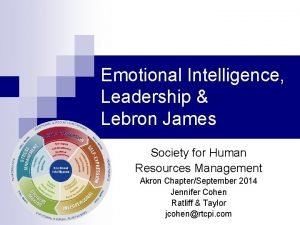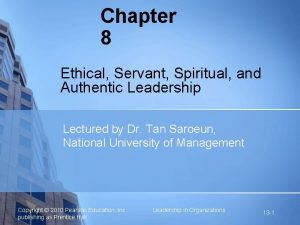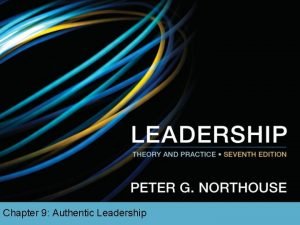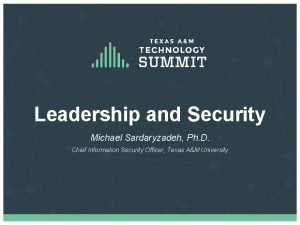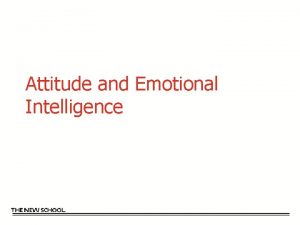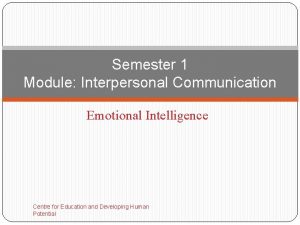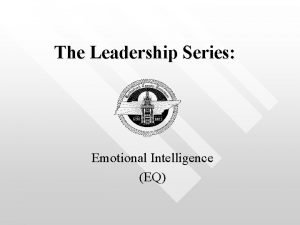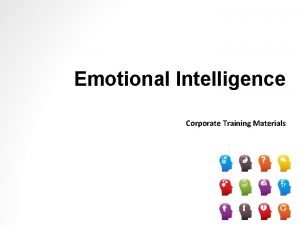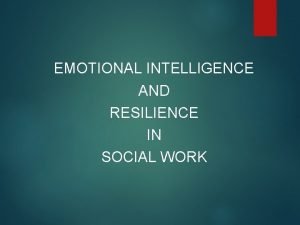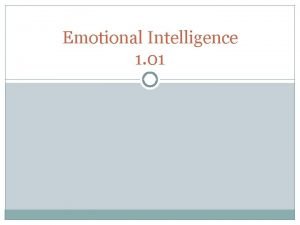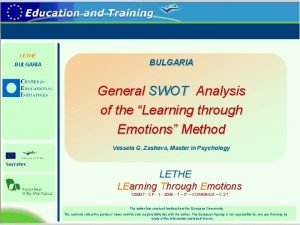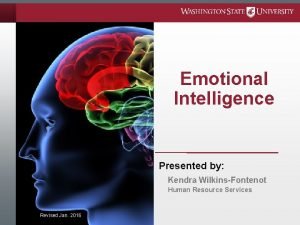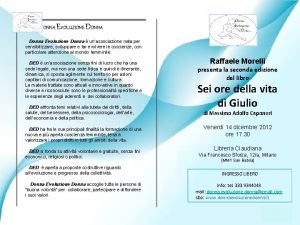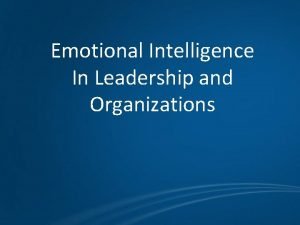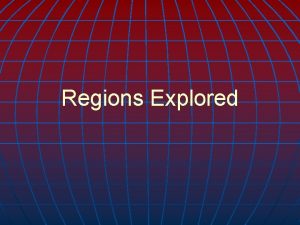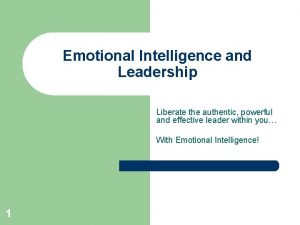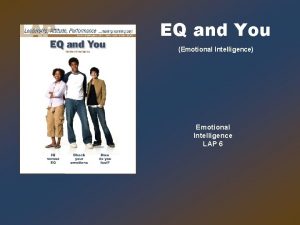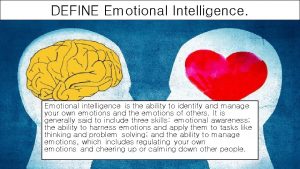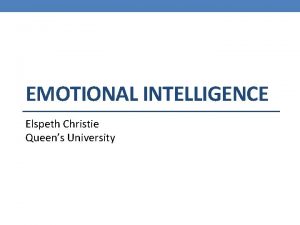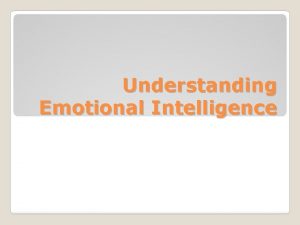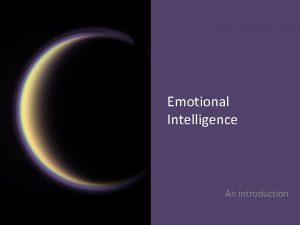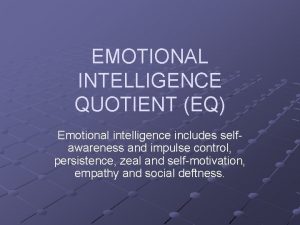Emotional Intelligence and Leadership AUTHENTIC LEADERSHIP EXPLORED Donna






















- Slides: 22

Emotional Intelligence and Leadership AUTHENTIC LEADERSHIP EXPLORED Donna Vandergrift, Dean, Liberal Arts Associate Professor, Psychology

What Makes a Great Leader? Take a second to think about this…. Great “Man” Theory Situationally Skilled Assumes that the traits of leadership are intrinsic. The leader choses action based on situational factors. Leadership is learned. Transactional Leadership is dependent on the interaction between the leader and the follower.

How They Make You Feel like you can trust them. Feel safe…like they have your back. Feel optimistic, hopeful. Feel good about the future.

Authentic Leadership The most recent focus is from Bill George, Authentic Leadership (2003) and True North (2015). http: //discoveryourtruenorth. org/ George suggests that authentic leaders demonstrate five qualities: Understanding their purpose Practicing solid values Leading with heart Establishing connected relationships Demonstrating self-discipline

Authentic Leadership Others have suggested that Authentic Leaders: Demonstrate behaviors which enable you to trust in them all of the time. Take ownership when they have made a mistake and share responsibility for any mistake. Question current status quo. Defend and support their people or processes.

Authenticity and Emotional Intelligence Authenticity is essentially tied to a leader’s capacity for self awareness and other awareness in that moment and staying true to who they are. This is a core part of Emotional Intelligence, which includes: Self-awareness Self-regulation Social awareness (empathy) Social skills (relationship and network building)

Emotional Intelligence Psychologists Mayer & Salovay (1991) defined Emotional Intelligence As the subset of social intelligence that involves the ability to monitor one’s own and others’ feelings and emotions, to discriminate among them and to use this information to guide one’s thinking and actions (p. 189). Mayer defined it in Harvard Business Review as: From a scientific (rather than a popular) standpoint, emotional intelligence is the ability to accurately perceive your own and others’ emotions; to understand the signals that emotions send about relationships; and to manage your own and others’ emotions.

Emotional Intelligence Daniel Goleman (Emotional Intelligence, 1995) “The most effective leaders are all alike in one crucial way: they all have a high degree of what has come to be known as emotional intelligence. It’s not that IQ and technical skills are irrelevant. They do matter, but…they are the entry-level requirements for executive positions. My research, along with other recent studies, clearly shows that emotional intelligence is the sine qua non of leadership. Without it, a person can have the best training in the world, an incisive, analytical mind, and an endless supply of smart ideas, but he still won’t make a great leader. ” The ability to understand your effect on others and manage yourself accordingly— accounts for nearly 90 percent of what moves people up the ladder when IQ and technical skills are roughly similar.

Biological Connections – Relationships Good leaders exhibit empathy and become attuned to others’ moods: This affects both the leader’s own brain chemistry and that of their followers. Researchers have found that the leader-follower dynamic is not a case of two (or more) independent brains reacting consciously or unconsciously to each other. Rather, the individual minds become, in a sense, fused into a single system. Leadership can improve when you learn the kinds of social behavior that reinforce the brain’s social circuitry. Leading effectively is, developing a genuine interest in and talent for fostering positive feelings in the people

Biological Connections – Empathy Mirror Neurons Help us to feel what other people are feeling (empathy) and allow us to imitate others, so we quickly pick up skills through imitation and observation. Emotional intelligence can mean we understand that some of the feelings we have are actually activated by our mirror neurons and we know how to express our own emotions in a way that influences others the way we want to.

Biological Connections – Mirror Neurons It was found that the delivery was more important than the message itself. Researchers observed two groups. One received negative performance feedback accompanied by positive emotional signals—nods and smiles; the other was given positive feedback that was delivered critically-with frowns and narrowed eyes. Later interviews revealed that the people who had received positive feedback accompanied by negative emotional signals reported feeling worse than did the participants who had received good-natured negative feedback. The more listeners understand what a speaker is saying, the more closely their brain responses mirror the speaker’s brain responses. Additionally, while normally there is a slight delay in a listener’s response matching up with the speaker’s, in cases of extremely high comprehension, the delay nearly disappears. In listeners who scored highest on comprehension, brain responses sometimes preceded the speaker’s.

Biological Connections – Mirror Neurons There’s a subset of mirror neurons whose only job is to detect other people’s smiles and laughter, prompting smiles and laughter in return. Someone who is self-controlled and humorless will rarely engage those neurons in his team, but someone who laughs and sets an easygoing tone puts those neurons to work, triggering spontaneous laughter and knitting his team together in the process. A bonded group is one that performs better. Being in a good mood, other research finds, helps people take in information effectively and respond nimbly and creatively. In other words, laughter is serious business.

Biological Connection - Awareness The anterior cingulate cortex, frontal insula and the amygdala are brain structures which affect emotional processes, selfawareness, and other awareness. They can give us “gut feelings”, messages that tell us when something “feels” right or wrong. They help us read our own signals as well as others’ signals. These parts of our brain can responds 100 times faster than the cognitive brain.

Biological Connections – Thinking Fast Spindle Neurons are larger neurons found in certain regions of the brain that quickly transmit messages. These neurons quickly convey our social emotions across the entire brain. After your cortex receives an emotional input, spindle cells use their cellular velocity to make sure that the rest of the cortex is also saturated in that specific feeling. These cells also help us gauge whether someone is trustworthy. Within one- twentieth of a second, our spindle cells fire with information about how we feel about that person This could be the basis for what we call Intuition. When we are self-aware, these “thin-slice” judgments can be very accurate. Great leaders who are self and other aware effectively act on these judgments.

Biological Connections - Reasoning In a recent study at the Wharton School, managers in an executive MBA program were asked to react to fictional strategic and tactical management dilemmas and measured their brain activity. When they examined the best strategic performers , it was found that there was significantly less neural activity in the prefrontal cortex than in the areas associated with “gut” responses, empathy, and emotional intelligence (the insula and the anterior cingulate cortex). In other words, the conscious executive function was downplayed—while regions associated with unconscious emotion processing operated more freely.

“ Authenticity is the alignment of head, mouth, heart, and feet - thinking, saying, feeling, and doing the same thing - consistently. This builds trust, and followers love leaders they can trust. ” Developing our Emotional Intelligence and our Authenticity

Develop Self and Other Awareness “Check in” with yourself. Express thoughts and feelings; label your emotions. Be in the moment. Know your strengths and weaknesses. Attend to how you affect others. Walk in the shoes of others. Attempt to manage someone else’s emotions.

Know Who You Really Are Tom Peters suggests that you should ‘define Brand You’. Being authentic doesn’t happen when you try to be like someone else. One of the 125 leaders George interviewed to define authentic leadership used to be Jack Welch’s assistant at GE in the 1980 s. Everyone was running around trying to be like Jack, he explained. You need to be who you are, not try to emulate someone else. Mentors are essential, though.

Develop your True North George suggests your True North is your inner sense, or your calling, of what you want to accomplish in your life. It’s a combination of your values, your beliefs, and your purpose. It keeps you on a straight track that’s true for you. There’s no two people for whom True North is the same. What is your life story? Are you staying true to it? Great leaders find their true north through the “writing” of their own life story. Leadership is a process that develops through a lifetime. Abraham Lincoln was once asked how long it took him to write The Gettysburg Address, the speech that defined a nation. He replied, ‘All my life’. ” Be Vulnerable – Open yourself up to others.

Trust Yourself and Harness Automatic Thinking Daniel Kahneman - System 1 “is the brain’s fast, automatic, intuitive approach, System 2 “the mind’s slower, analytical mode, where reason dominates. ” Kahneman says “System 1 is. . . more influential…guiding…[and]. . . steering System 2 to a very large extent. ” Malcolm Gladwell – Suggests that "thin-slicing“ is our ability to use limited information from a very narrow period of experience to come to a conclusion. This idea suggests that spontaneous decisions are often as good as—or even better than—carefully planned and considered ones. Mihaly Csikszentmihalyi - Flow is a state of mind during which people become so involved in an activity, times seems to fly by, focus becomes sharp, and people experience a loss attention on the self. Abraham Maslow – Self actualization leads to an understanding of self and others, and peak experiences lead even more personal awareness and understandings that were not accomplished before.

Focus on Building Relationships Talk with others, listen more. Manage stress – yours and those around you. Understand your non-verbal communications. Use humor and lightheartedness with others. Work on conflict resolution.

Thank you!
 Global leadership foundation emotional intelligence test
Global leadership foundation emotional intelligence test Ethical servant spiritual and authentic leadership
Ethical servant spiritual and authentic leadership Authentic leadership theory and practice
Authentic leadership theory and practice Which phrase correctly describes the tang dynasty
Which phrase correctly describes the tang dynasty The dark romantics explored
The dark romantics explored Authentic leadership focuses on
Authentic leadership focuses on Leadership authentic
Leadership authentic Bill george authentic leadership model
Bill george authentic leadership model Attitude and emotional intelligence
Attitude and emotional intelligence Interpersonal communication and emotional intelligence
Interpersonal communication and emotional intelligence Objectives of emotional intelligence
Objectives of emotional intelligence Oka emotional intelligence
Oka emotional intelligence Emotional aptitude definition
Emotional aptitude definition Emotional intelligence index
Emotional intelligence index Emotional intelligence happiness
Emotional intelligence happiness Emotional intelligence flowchart
Emotional intelligence flowchart Emotional intelligence training materials
Emotional intelligence training materials Emotional intelligence in social work
Emotional intelligence in social work Goleman's four domains
Goleman's four domains Tows matrix cp all
Tows matrix cp all Emotional quotient
Emotional quotient Emotional intelligence advantages
Emotional intelligence advantages Emotional intelligence in hrm
Emotional intelligence in hrm
